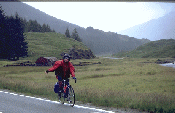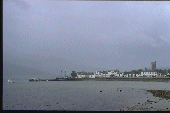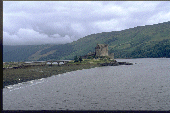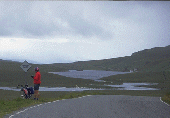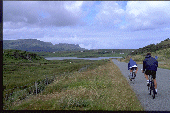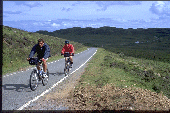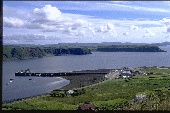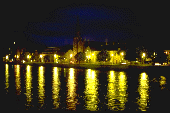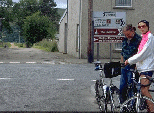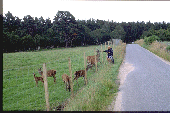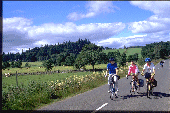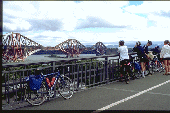|
|
|||||||||||||||
|
Tour
1999: SCOTLAND Glasgow - Inveraray - Glen Coe - Skye - Loch Ness - Inverness - Braemar - Aberdeen - Perth - Edinburgh. Km.: 800 (+ 200 train and bus transfers) -days: 10- Month: July NEW! Click to see a MAP
Click on thumbnails to zoom;
there are more pictures in
the photo
album. Click below.
For those of you wondering how
Scotland fares as a cycling destination, let me say right away that there are
actually a few things to recommend it. The distances are perfectly
manageable, it is possible to cycle the better part of it in less than a
couple of weeks (we almost did). There are some challenging climbs but
nothing as daunting as we southern europeans have in the Alps or the
Pyrenees, and then, of course there’s the scenery, vast, majestic, unspoilt
(or at least it looks like it when you move through it at cyling speed...),
that makes most other european landscapes look and feel a bit like theme park
rides... Then, since most of you will already have been warned about the
inconveniences of cycling in Scotland... I’ll just say that everything you
have heard is true, and add some caveat about a couple of other things
that may not sound as familiar to you
as whisky, castles, kilt, ...and
rain. The first is road traffic. The Highlands of Scotland, being sparsely
populated, do not need per se to have an extensive road network.
Because of its popularity as a tourist destination, however, the capacity of
the aforementioned network is stretched
nowadays well beyond its limit, expecially in the summer. In addition,
it looks like everything commercial
runs on wheels as well around here. You may find some less frequented
road every now and then, but they may not take you exactly where you want to
go, unless 50+ miles detours are not a deterrent to you. The second thing I
meant to warn you about is the midge... but of that later, I don’t want to
get ahead of my story.
We start our tour
from Glasgow, which we leave too soon (if anything, because the sun
is shining there...), lured by the celebrated shores of Loch
Lomond, which, try as we might, we fail to reach before they become
completely hidden under a low and rainy overcast. Now, if you happen to have
a map of Scotland at hand, you may check it to see how far Loch Lomond actually
is from Glasgow, and conclude, as we did, that sightseeing in Scotland may be
a lot of different things, including something extremely enjoyable and
rewarding at times, but it can never... ever, be planned ahead! We have time
to meditate this lesson, learned in less than an hour of cycling, over coffe,
fried eggs, chips and other roadside cafe’ fare in (you have guessed right) a
roadside cafe’ where we take refuge waiting for the rain (which in the
meantime has tourned into a downpour)
to stop. When it does, our morale receives a considerable boost (we
learn fast...). We jump on our bikes and, after a left turn
we enter the Argyll region. Then, under a light drizzle (how wonderful, almost pleasant...), we
start to climb the infamous Rest-and-be-thankful pass. A well chosen
name, no one would argue with that, but we feel others would have suited it
equally well, like Stiff-Neck Gap, for instance. In fact, as soon as
we reach the top, drenched with sweat and drizzle, a furious wind blasts us
like the proverbial fire hose, and we have
to put on everything left in our cycling wardrobe to tackle the steep
descent toward Loch Fyne. Finally, when we get there, the rain stops,
and, when we ride along the coast road to get to Inveraray, some rays
of sunshine appear through the clouds and
suddenly the loch shores are bathed in the northern late afternoon
light. Inveraray is a pretty little town that has practically just one
street, but it has also a Youth Hostel, with small but cozy (when your
clothes are dry, that is) rooms, and a pub that serves excellent food (and,
being on Main Street, may be considered one of the Most Easy to Find pubs in
the world).
The following
morning begins dry but under a sky whose murderous intentions appear clearly
enough. In fact, after ten minutes of so, violent squalls start to pelt us mercilessly,
and the only consolation (for me) is to have had enough foresight to equip
myself with a pair of waterproof overshoes (which I had to throw away at the
end of the trip: better them than the shoes, of course). When we reach scenic
Kilchurn Castle, however, the rain has already stopped. The sky
remains menacing, but we cycle the lenght of Glen Orchy¸ following the
course of a turbulent, foaming, peat-coloured stream, without getting a drop
of rain, until we reach the Bridge of Orchy, an important road
intersection at the foothills of the Highlands. The restaurant strategically
positioned near the crossroad serves excellent food (this one too...) and
drinks (venison stew, beer...), and we are in no hurry whatsoever to leave,
given the fact that in the meantime it has started to rain buckets again. And
again... the rain obligingly stops as soon as the food is digested and the
glasses emptied (may there be a method in the madness of Scottish weather?).
The road begins to
climb almost immediatly and, sure enough, at the top of the climb a sign
informs us that we have entered the Highlands. We notice that every
sign of human presence has practically disappeared from view (except for the
road, thank God, and the cars that zoom past
– sceptics will always find plenty of evidence in their favour too
...). The view stretches for miles around on a vast, windswept plateau. It’s
only after cyling a good number of those miles that the first Munros (the
sugarloaf-shaped, green peaks that tower –as if it wasn’t impressive enough-
over the Highlands landscape). As the Munros thicken, and a couple of
white little cottages lost on a sea of green appear, we know that we must be
approaching Glen Coe, arguably one of the most remarkable of Scotland
sights (says all...). To me, Glen Coe looked a bit like a green-coloured
version of Utah’s Zion Canyon. It’s one of the few places in Europe where the
vastness and the wildness of the landscape approach those of larger
Continents. Incredibly, we manage to reach the hostel completely dry. But
late in the evening it starts to rain again and this time (although we don’t
know it yet) it will be for good... It’s still raining the next
morning when we get up, and there’s no sign it’s going to stop (it won’t, in
fact...). Had we waited for it, breakfast will have turned into lunch. As it
is, we have ample opportunity to browse the impressive collection of climbing
memorabilia featured in the cafe’ (including pictures of British star
climbers, and of Clint Eastwood on the set of The Eiger Sanction:
Glen Coe is in fact an hallowed spot of British climbing –Hollywood climbing
too, it seems...). Finally, deterred not only by the rain but more
significantly by the heavy morning traffic (lorries raise splashes so high they
look as they might swamp a munro, let alone a cyclist... -and lorries
is what they call trucks here, man...), we decide to put our bicyles on the
van (you didn’t really think we went on this trip without one?), and reach Fort
Williams by means of public trasportation (no, we didn’t simply jump the
bunch of us on the van. Why? Because you can’t do that, you know...) When we get there, it’s still raining,
and the summit of Ben Nevis is invisible under the clouds. But we
can’t put off our departure much longer. So under the rain (that is finally
starting to thin) we climb to Shiel Bridge then we start the
interminable, -and considerably treacherous under this wet conditions-
descent toward Loch Duich. When we reach the foot of the descent, with
the sharp left turn that leads on the shores of the Loch, we are so stiff
with cold that we have trouble negotiating the turn. Luckily, we don’t need
to, because strategicaly positioned right in front of us on the other side of
the road is a petrol station cum Cafe’ that we enter head-on first....
After filling up on cakes and tea (an operation that takes considerably
longer than filling up a car) we regain the road and we soon realize (not
immediately, we have got used to it in the meantime...) that the rain has finally
stopped (after almost twenty hours without interruption...) We allow ten minutes to take a look of the
famous Eilean Donan castle
(already closed by the time we get there, anyway), and finally we reach the
Hostel in Kyleakin ( open,
fortunately), after crossing the imposing (and controversial) Skye Bridge.
In just three days of riding from Glasgow we
have reached the island of Skye, a place that looks in many
ways as if it belonged to another continent (the fact that they speak English
here too doesn’t say much, of course, they do very much the same in Canada,
South Africa, and Australia...). Its
dimensions are respectable, so that it would take as many days to tour it
properly as it took to get here. We have only one day so we concentrate our
efforts on a loop around the Trotternish peninsula, at the north-east
tip of the island. What we hope most is that the weather is not going to
spoil the experience of one of the most renowned scenic spots of all Scotland. And to answer our prayers (and
maybe also to reward our stubborness and forbearance), Scotland finally
decides to give us one day of totally perfect good weather: sunny sky, warm
temperatures, no wind, something that around here in summer happens sooner or
later, but is in any case extremely rare. We are duly appreciative, and aware
that a day like this on a place like this is going to make our tour, no
matter what happened so far or what will follow. But even a day like this
doesn’t come without inconveniences... The warm, still air of the evening,
brings out swarms of midges (I know you have been waiting for this part....),
and since our mediterranean minds cannot even begin to think about staying indoors in this fine weather, we
are soon locked in their infallible radars and made the target of their relentless attacks (just when we were
starting to wonder why we were practically the only people hanging out in the open).
The scottish midge (a very small fly, according to the guidebook, although I
couldn’t care for it less if it was a very small sea elephant...) gives you
a fastidious enough bite, but that’s not the worst part... but again, I don’t
want to get ahead of my story...
The stage for the next day entails retracing
a good part of the route of the day before. This time the interminable
descent from Shiel Bridge is, of couse, an interminable climb... The weather
has deteriorated again, and if showers last only minutes, their frequency
seems to be dictated by a celestial metronome. The climb to Shiel Bridge is
long, but the gradient is not too steep, and today the cloud ceiling hangs
higher, so we can take solace from our exertions by admiring the vertiginous peaks that tower above Glen
Shiel. After having completed the descend, however, we take the direction
opposite to Fort Williams, and we enter the great valley that bisects the
scottish Highlands in two from the Atlantic Ocean to the North Sea, and whose most obvious feature
is, of course, Loch Ness. We reach the Loch through valleys covered
with pine trees, riding along clear mountain streams crossed every now and
then by narrow stone bridges that were probably already there when riders
(rather than their mounts, as it is in our case) were coated with iron. As long as one expects from Loch Ness the
same experience that every visitor has had since it has risen to worldwide
fame (i.e.: not seeing the monster), one will not be disappointed by
it. And you can’t really blame the monster for making himself scarce. Loch
Ness in summertime is uncontested Midge Country, and no beast, however huge
and powerful, would stand a chance faced with a million or so of those little
bug...s, any more than would (regardless of whether this may be actually
possible) a great white shark attacked by
piranas. In fact, by now we have discovered the really annoying effects
of the midge bites: an allergic reaction that erupts in a highly visible
rash. Half of our group is affected by it, some in a more conspicuous manner
that others, and none more so than myself (I look like one of those
polka-dotted cartoon characters). So the only future a monster hanging around
these parts may hope to have would probably be in Eurodisney. Today we discover that there is a monster
living around Loch Ness after all, one too
tough to chew (or bite) even for the midge. It’s made of metal, in fact, and stretches
its several kilometers long tail from Fort Williams to the outskirts of Inverness.
It’s the traffic that infests the A82, the busiest road in the Highlands.
As soon as we stick our front tyres outside the gates of the Hostel, it
swallows us in one bite. We try to escape it one first time by stopping to
get a glimpse of Urquhart Castle, but here too it stretches its ugly
bloated belly to engulf the stately looking ruins in a spectacularly
monumental parking lot. We make a second most succesfull attempt by taking a
left turn into Glen Urquhart. But as in a masterfully directed horror
film, another nasty surprise awaits us here: the mother of all Showers, apparently coming from nowhere,
drenches us in minutes and turns the road into a torrent in spate. Only when
we spot a welcoming restaurant floating above the waters we get reassurance
that the road has not been swept away after all... We must have done our
familiar propitiatory restaurant routine particulary well this time, because
the rain (even if we don’t know that yet), decides to leave us be for the
rest of the trip. We cycle further past Glen Urquhart and enter scenic Glen
Affric, where the road climbs until we reach a point where it appears to
stop, as if it had nowhere else to go, as if we had reached the heart of the
Highlands itself (with a view that
makes it look very much as if we actually did). In fact we are only a couple
of hours by bicycle from Inverness, and the Hostel that we must reach before evening.
Rather than letting us off completely, the rain
has apparently decided to let the wind have its turn with us. Fortunately, we
are now in a place that possesses the best remedy of all to the most
inclement weather: Whisky. We are in fact passing through the Speyside, Scotland’s
most renowned whisky producing region. Here distilleries are ten to a mile,
and we pick the one we finally get inside to completely at random. Inoculated
agains the cold and the wind we find the going on a road that has very few
straights surprisingly easy (the trick is to take the first turn in the right
direction, and the rest will follow...). Things get harder when the road
starts to have very few flats. The bit of the Lecht Road that
crosses the Cairngorm Mountains is the mountain stage of our
Tour (today with capital T). There are at least three climbs of between two
and five km., with gradients that get as steep as a punishing 20%! If we had
any doubts about this being the real thing, at the top of one climb we spot a
couple of parked snowmobiles, and another couple of long rows of identical
square metal frames that can only be the supports of a ski-lift cable. This
is in fact one of Scotland (and consequently Great Britain) major ski areas.
Actually these hills are seldom higher than 1000 mt. But this is enough to
get them covered with snow in winter, and, all year round, to enjoy from
their top breathtaking views that sweep for kilometers around on a landscape
as rugged, wild and pristine as those (one imagines, in this case...) of Canada
or, say... Alaska. A last, winding and steep descent takes us on the Deeside,
where the road finally gets flat again until we reach
Braemer. One can say whatever he pleases about
Britain’s Royal family (and I won’t normally argue), but you surely can’t
fault them for chosing Balmoral Castle, as (one of) their residences.
They are, however, amongst the very few who can afford a mansion in this
enchantingly beautiful valley. Everybody else must stay in Braemer (which
looks posh enough in itself), the only resort (in fact the only town of any size)
for miles around. Today we are going to cycle the lenght of the Deeside to Aberdeen
(and, consequently, the sea). A long ride but an easy one compared to
yesterday. The road is flat and sheltered from the wind, and the weather
today is pleasantly sunny and warm. As a consequence, our ride takes the
tones of a countryside trip. Along with families of deers, confined in fenced
spaces and easy to pet, the Deeside hosts more elusive species of which we
manage to get a glimpse nonetheless, like foxes for example (our silent mode
of propulsion helps, of course). After Glasgow and Edinburgh, Aberdeen is the
largest sized city on our trip. To visit it, though, as well as all the other
places where we stay, we only get the evenings, when in our legs there’s barely
energy left to stagger to the nearest restaurant or pub. Arriving in Aberdeen
on a saturday night, we notice that a lot of other people seem to have
problems walking straight as well. Why, nobody told us that in this city
lived so many keen week-end cyclists...
The following day starts sunny but blustery, with the wind mostly
coming from right in front of us. Along the first part of our road there’s no
much shelter from it, as we advance on a flat coastal plain to Dunnottar
Castle, a forbidding ruin perched on a rock overhanging the North Sea. It
had to look menacing, to deter Vikings raids, and even so it wasn’t always
effective. Not only was this part of Scotland east coast directly on their
path, it was also a lot more appealing than the rugged, inhospitable interior.
From the middle ages until today the Angus Coast and the Strathmore
have been the best farming areas of Scotland north of the Clyde and Forth
estuaries, and the towns that we meet on the road with increasing frequency
all had their bustling fairs and markets. There where rich abbeys, vast
feudal estates, and busy mills, like the Mill of Benholm, today
restored after its XVII century aspect. The town of Montrose,
where we stop to have lunch, has a number of monuments to remind of its past
from the Middle Ages to the Union and Victorian periods. Before we reach Perth,
the destination of today marathon stage, the terrain becomes more hilly, as
we pass through the Strathmore, keeping on our left industrial Dundee, and ,
more regrettably, Glamis Castle, of Macbeth fame (alread closed
at this time, again...). The steepest climb of all is the one leading to the
Youth Hostel in Perth. Perth was for a certain time the capital city of Scotland. It is in fact
ideally situated at the crossroad of the Highlands, the Angus Coast and the
Fife peninsula. It would provide a very convenient base to a number of
interesting rides, except that today, alas... is our last: everybody has got
a plane, a train or a bus booked to his or her trip back home. Even if
today’s stage is not much more than a connecting ride to Edinburgh, it
has its share of points of interest (aside, of course, Edinburgh itself...).
We cross the wooded Ochill Hills until we reach Kinross, on the busy shores of Loch
Leven, a favourite destination
for Edinburgh fishing
aficionados. And just before reaching Edinburgh, of course, we have to cross
the Firth of Forth, the european answer to the Golden Gate. From the
road bridge, we enjoy a memorable view on the Forth and the Railroad
Bridge, contemporary and technically akin to the Eiffel Tower, but bigger
and heavier. The outskirts of Edinburgh are already visible on the
southern shore of the estuary, but, the estuary itself being more than 40 km.
long, the North Sea remains invisible below the line of the horizon. Don’t forget to browse the photo album for
more pictures. |
|
|
[Home Page]-|-[ France]-|-[ Ireland]-|-[ Italy]-|-[ Germany]- |-[
Sweden]-|-[ Norway]-|-[ United States]



